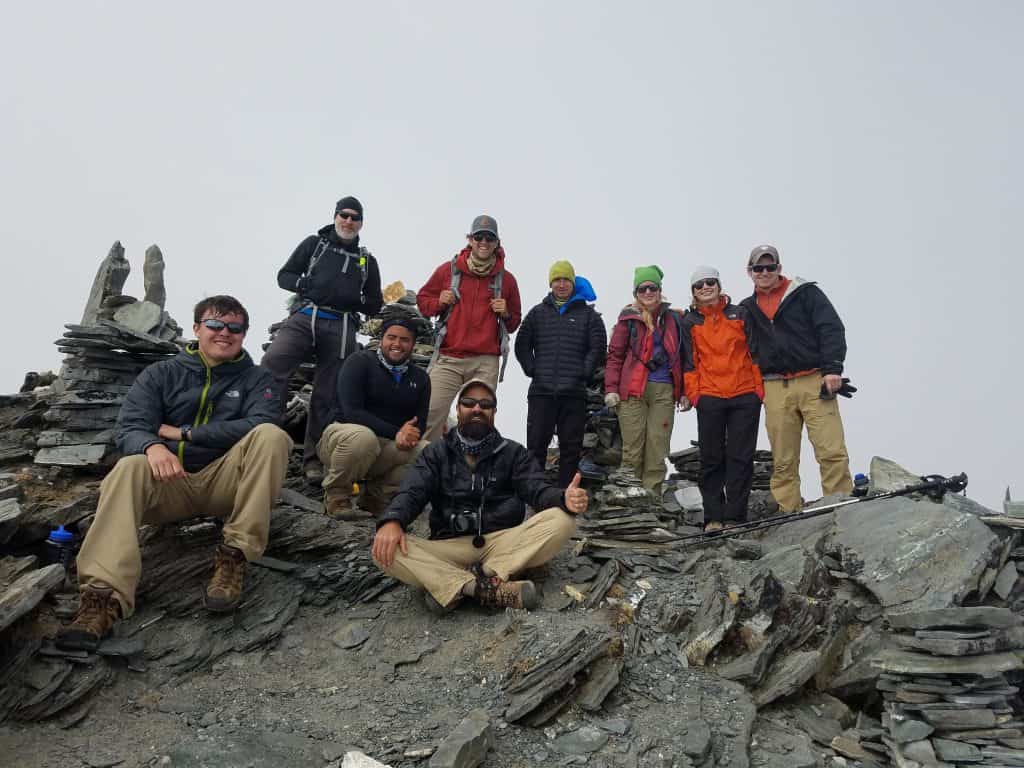International Outing Washington and Lee's Outing Club travels to Nepal for eight-day Khumbu trek
“The landscape was fantastic, and the group dynamics were fantastic. Although we were there for a short time, we got a taste of what there is beyond our borders, and that’s what makes travel so interesting.”
The mantra for the Washington and Lee Outing Club’s eight-day Khumbu trek in Nepal quickly became “Down to river, up to mountain.” A reference to the topographical pattern of the trail, it’s what kept the group going during the unexpected 12-hour hike the day after summiting Chukung Ri (18,000 ft), which proved to be a difficult physical and mental test.
Physical rigor is to be expected on Outing Club trips. During the school year, students go spelunking, white-water rafting, or sea kayaking in the Everglades. The yearly international trip goes farther afield, and this year, James Dick, director of student activities and outdoor education, led a group of 10 on a hike through the foothills of the Himalayas. Over the past 10 years, Dick has led trips to Costa Rica, Belize, Tanzania, Kilimanjaro, Ecuador, Peru and Slovenia.
Compared to W&L’s popular Alumni Traveller programs, the Outing Club expeditions focus on adventure. “The idea is to spend most of the money on the actual experience rather than fancy food and accommodations,” explained Dick. “So we stay in B&Bs, youth hostels, pensions — not quite camping, but close.” He ends the trip, however, in a nice hotel, because “a hot shower feels really good.”
This year, before hitting the trail, the group had a day of sightseeing in Kathmandu, Nepal. They visited a few important landmarks, including the Pashupatinath temple, the Boudhanath Stupa and Bhaktapur Dubar Square. “We also saw a lot of ongoing repair work to buildings damaged by the 2015 earthquake, as well as tent cities of refugees who were desperate for work,” said Dick. One of the more memorable moments was witnessing a cremation ceremony and then watching the ashes being swept into the river. “That was a very emotional moment, seeing the family saying good-bye to a loved one,” he said.
“What struck me about Nepal’s people was their excitement to see tourists,” said Albert Civitarese ’15, who will be attending the Philadelphia College of Osteopathic Medicine this fall. “Countless times, they thanked us for visiting. They were excited to share their culture and were eager to learn more about ours. Initially, I was taken aback by these responses, yet in hindsight it fit perfectly with the Nepali people’s personalities. They had a strong sense of national pride and championed what their country had to offer, as both a tourist destination and a home. This was not without realizing its flaws or drawbacks, which they would openly discuss at length, if asked.”
Even though the group had previous hiking experience, the going was tough. “Our first segment, from Lukla (9,000 ft) to Phakding, was hard,” said Dick. “It was a difficult climb in the dark and the rain.” But the next few days offered diverse hiking and visits to teahouses and monasteries. Prayer flags blowing blessings in the wind, and shrines carved or painted with Buddhist mantras, lined the path. “You always walk to the left of them,” noted Dick. All supplies were strapped onto yaks, and the group carried individual daypacks. Meals included lots of carbohydrates — fried potatoes or noodles with vegetables, as well as dal bhat, a rice and lentil curry.
Hiking at altitude presented its own set of problems. “People were really tired,” noted Dick. “We were taking pulses through the night and had some meds on hand to counteract the affects of altitude sickness.” As the group approached the summit of Chukung Ri, altitude took its toll on a couple members. “During our summit hike, James Lewis ’14 and I were laughing the entire way up the bluff,” said Civitarese. “Everything was gut wrenchingly funny, and only our labored breathing could interrupt this apparent comedic act as we inched our way up the mountain. With the timeline of the hike and our elevation change, slight AMS symptoms were inevitable. When we returned from the summit, I developed a strong headache and overall body ache.”
Leading them throughout the trip was Head Guide Karma Sherpa. “He was extremely outgoing and informative,” said Dick. “There were stupas all along the way, and he even led us in a few prayers. He was so outgoing and professional.”
“It was a really tough climb,” acknowledged Dick, “but it was one of the better trips I’ve done in many ways. The landscape was fantastic, and the group dynamics were fantastic. Although we were there for a short time, we got a taste of what there is beyond our borders, and that’s what makes travel so interesting.”
“I both praise and curse James Dick for planning this trip,” said Civitarese. “Without a doubt, trekking in Nepal is one of the most unique and amazing experiences I have ever had. While the national parks in the U.S. would be able to provide similar views collectively, this single trek encompassed so many different beautiful landscapes I do not believe I will be able to ever top it in my life. Thus, my disdain for James. I fear Nepal has ruined me for hiking elsewhere.”


You must be logged in to post a comment.